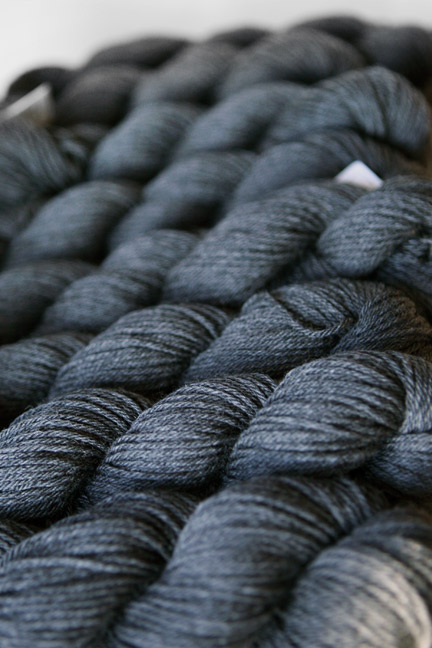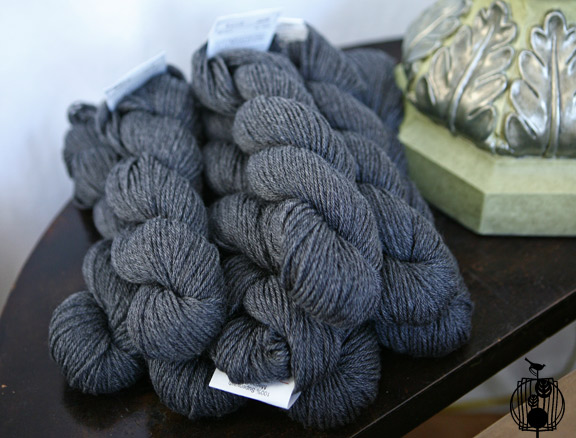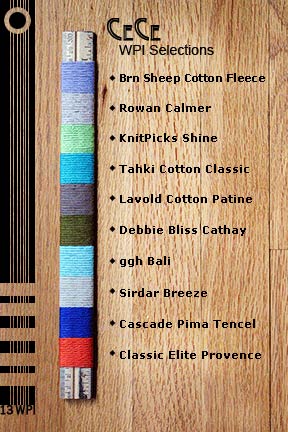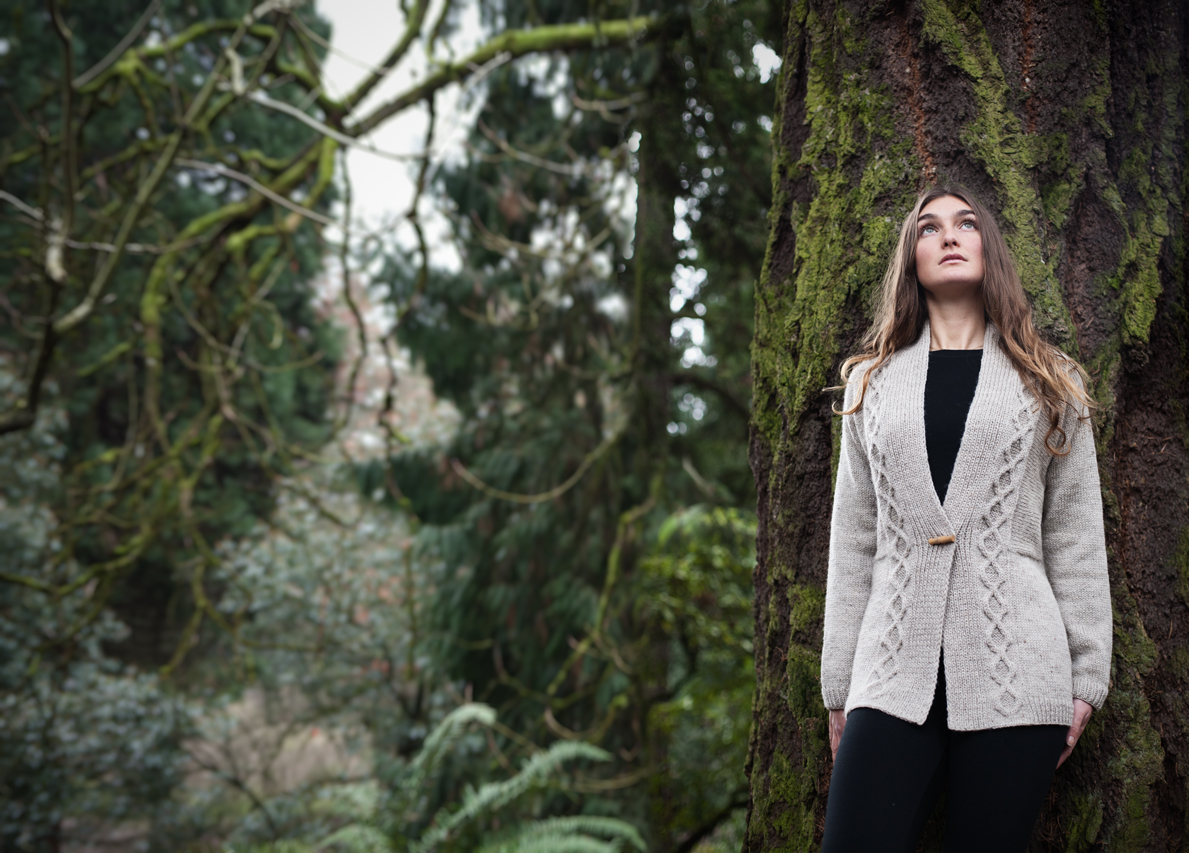Here’s the entire sweater.

Well. Almost.
Now that swatching is finished, it’s time to wind the skeins into mobile balls. Whew. That’s a lot of yarn.
Although I’m sure it is less wear and tear on the fiber, it’s also easier for me to digest as a small task as opposed to one that chases away the muse so this is a process I usually go into one by one, for a couple of reasons.
I have a beechwood (?) swift and a plastic winder that’s anchored to a little step ladder. It seems that no matter how I apply tension or speed on the winder, it’s always a 2-part process to make a usable center-wound ball that isn’t too tightly wound and stressing the yarn. If I wind for less tension, sometimes the ball is so loose, it comes completely off the winder and shoots across the room! If I wind with what feels like normal speed, on the first pass, it’s always too tight, and I re-wind that 1st pass. (Do you wind all your yarn for a project at once?)

I am really in love with this grey. It has a hint of heathering, but is mostly solid. These test shots in the morning light show its basic goodness. ;p
But it is its gauge that we want to explore here.
I went digging in the Studio Chic Knits archives and found this entry from several years ago. Here is the wrap test I did for the CeCe design, which like the Vonica design that I’m making, also uses DK weight yarn knit at 5 sts per inch instead of 5.5 sts per inch.
The wrap test revealed that the behaving size of yarn was: 13 wpi.
Vintage Studio Chic Knits

It was a bit of a Wrap Fest last night at Chez Chic. Imagine, if you will, being surrounded by quite a few balls of yummy spring colored yarns – and then going wack. Or should I say, Wrap.
Bowing to The Geek Within, I sacrificed a wooden ruler and proceeded to cover it with yarn – specifically, yarn I thought might work for the CeCe cardigan. I wrapped each strand side edge-to-side edge around the ruler, no overlap; no gaps, filling the ruler’s 1-inch segments. As I wrapped and wrapped, it got to be colorful and quite enlightening.
All of the yarns you see above wrapped to 13 WPI (Wraps per Inch). This is, I’ve found, referred to as DK weight. Sporting Weight is 14-15 WPI. Worsted is 12.
Some yarns I picked didn’t make it on the ruler – I was dying to try a Gedifra yarn called Wellness, but it was too thick – came out spot on 12 WPI – meaning it was a worsted. Then there was an unlabeled mercerized cotton I had that came out 14. I was intrigued.
Why does this make so much sense compared to the ambiguous title/standards you see elsewhere? Although each yarn is not identical to the others in fiber content and/or spin, they seem to share a common diameter that would indicate they could be used in the same way. [Keep in mind drape characteristics are not identical but very close as unscientifically determined by me feeling all this YARN!]
Does anybody out there always go by this test instead of the ball band? I have a love/hate relationship with ball bands. What they truly reflect is the *Put Up* or weight of the yarn sold, not the Diameter RANGE of it. That’s why there is so much variation (and confusion). Cotton weighs more than wool. Check. But what really determines a yarn’s knitability is diameter and drape. I know the ball bands are a starting point and I would recommend that a knitter use, to begin with, whatever needle size they suggest. But most patterns have the line: OR NEEDLE SIZE TO GET GAUGE for a reason – if you substitute, part of the fun is knowing in advance you might have to deviate from the
dangersafety of the ball band.Here are the needle sizes I use for these standard gauges [gauge followed by US needle size]:
24/32 3-5
22/30 4-6
20/28 5-7
18/24 6-8
16/22 9
14/20 10-11Garçon! Bring me an order of WPI & Swatch to Go, s’il vous plait…


Enlightening. Thanks!
This is so helpful. I seem to have so much trouble with gauge and this helps me understand why I’ve struggled with it.
Wraps are too variable for me. How do you compress or not compress the yarn to get a reliable number? As for winding balls, I always wind twice as well to get a nicely intentioned unstressed yarn.
The winding question is a good one. Sometimes I wind all at once, this latest project, I have only done a few skeins at a time (mainly because my toddler makes knitting through multiple balls of yarn in the near future very unlikely). I have noticed that I like to wind my own yarn–and have refused the offers at the yarn store to have my yarn wound there. I think the hand made cherry swift I picked up online is part of the reason…
I agree with Merna. I never wrap because I can’t seem to find a consistent way to do this. Any suggestions on wrapping? I am a loose knitter, so I always start with a needle size smaller than recommended to do a swatch. It almost always works, except for stranded knitting, where I automatically go a needle size larger because for some reason I knit stranded very tightly which I expect is because IT STRESSES ME OUT!
There is another way to check wraps. The iPhone app “A Spinner’s Toolkit”. There is no wrapping involved; you just lay the yarn in the spaces and determine wpi without tension or compression. I use it all the time when I spin. It has many other features my spinning friends and I use.
Hi Bonne Marie…thanks so much for the informative article and with all your helpful tips and blog notes, I will put this to good use….now, for the really important question…the YARN details in that glorius shot? I LOVE that and must purchase some…can you share the details?
Thanks so much, and as always, thanks for your beautiful, designs for “real” women and your fantastic construction details.
donna
I am SOOO glad you wrote about this Bonne Marie. Once I always thought it was “just me” as I believed that the manufacturer would not be wrong in their information re what needles to use and what gauge was correct for the yarn and would be achieved by using the needles stated. I have done some experimenting myself as I found that all DK yarns here is Australia are NOT the same thickness and have learnt the “hard” way to always check regardless of what is stated on the band. Many thanks!
Personal preference as far as yarn info is for weight per distance–yards per pound, meters per gram, any combination of the above. With WPI, I always wonder about tension as you wrap–some people pull tight, so the yarn stretches and you get more WPI, some people leave it looser and you get fewer because the strands are fatter.
The manufacturer knows (or should!) know how many distance units they’re selling me per ball/hank/chunk o’ yarn. Does it really take that long to weigh one of your yarn chunks and tell me?
And don’t get me started on the “1 means lace, 2 means fingering” nonsense.
I go by yardage and my swatch (in some cases three or more swatches). And I only wind one ball at a time because I have a swift but no ball winder but my own hands and because if I don’t use the last ball, or I abandon the project after one skein, the rest of the stash is intact.
Lucinda, I can’t find A Spinner’s Toolkit in the app store. Can you give more specific info on where to find it? An iPhone app would be worth a try.
The app is actuall called the iSpin Toolkit: http://bit.ly/2shZAo
Looks interesting!